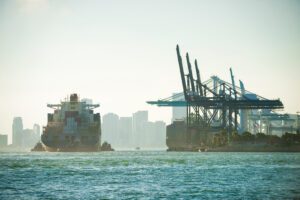The opening of a fourth berth at London Gateway next month marks the start of a fierce competition with Felixstowe to become the UK’s largest port.
This expansion, funded by Dubai Ports World (DP World), will increase the port’s capacity by over a third, positioning it to challenge Felixstowe, owned by Hong Kong billionaire Li Ka-shing’s Hutchison Ports.
Located on the north bank of the Thames, the new berth at London Gateway will extend its quayside capacity to over a mile. With 16 quay cranes, each as tall as the London Eye, the port will be equipped to handle four 400-metre ultra-large container ships simultaneously. The addition of a potential fifth berth could further solidify London Gateway’s ambition to eclipse Felixstowe.
Ernst Schulze, chief executive of DP World’s UK Ports & Terminals, including Southampton, stated: “We expect to overtake the competition within five years.” The new berth will become operational in August and fully functional by year-end. Currently, London Gateway can handle 2.4 million TEU annually. The fourth berth, costing £350 million on top of the £2 billion already invested, will increase capacity by 35 to 40 percent, adding another 1 million TEU per year.
The port’s growth aligns with DP World’s vision of a “Jebel Ali-on-Thames,” transforming it into a significant free trading outpost. A key component of London Gateway’s expansion is its adjacent logistics park, with potential for 9.25 million sq ft of warehousing. This facility, already more than half occupied, hosts storage for perishable goods, electronics, alcohol, and bonded warehouses for tax purposes.
The logistics park, currently employing 1,500 people in addition to 880 port workers, aims to become the largest of its kind in Europe. Schulze highlighted the park’s role in the Thames Freeport, which could attract light industrial units benefiting from tax incentives.
Schulze emphasized the necessity of expanding London Gateway: “Britain needs more port capacity and the right infrastructure to handle the largest vessels. We have the land for expansion.” He also pointed out the importance of building resilience against supply chain disruptions, as experienced during the pandemic.
Growth drivers for London Gateway include capturing volumes from other UK ports, increasing containerisation, and overall growth in the British economy. The port claims a dominant share of UK imports from South America, Africa, Australasia, and the Mediterranean, accounting for 75 percent of this segment.
While Felixstowe, which handled 4.2 million TEU in its peak years, remains a formidable competitor, it will be challenged by London Gateway’s ambitious expansion and strategic positioning.





